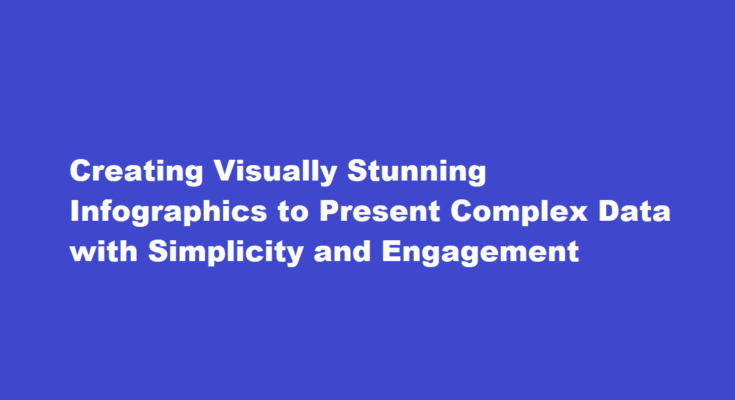Introduction
In today’s information-driven world, data plays a crucial role in decision-making, problem-solving, and communication. However, raw data can be overwhelming and difficult to comprehend. To make complex data accessible and engaging, visual representations like infographics have become essential tools. Infographics combine art and data to convey information in a simple, appealing, and memorable manner. This article will explore the key steps to create visually stunning infographics that present complex data in a way that captivates audiences.
Define Your Objective and Audience
Before diving into design and data visualization, establish a clear objective for your infographic. Ask yourself, “What message do I want to convey?” Identify the core data you want to present and the key takeaways you want your audience to remember. Understanding your target audience is equally vital as it will shape the style, tone, and level of complexity of your infographic.
Collect and Organize Data
Gather relevant and reliable data from credible sources. Complex data often requires meticulous organizing and simplifying. Avoid overwhelming the audience with excessive information; instead, focus on the most crucial aspects. Group related data points and establish a logical flow to ensure that your infographic tells a coherent story.
Choose the Right Visualization Techniques
The success of an infographic largely depends on selecting the appropriate visualization techniques. There are various options, including bar graphs, pie charts, line charts, maps, and flowcharts. Consider the nature of your data and the story you want to tell. For instance, use pie charts to display percentages, line charts to show trends over time, and bar graphs to compare different categories.
Design with Purpose and Simplicity
An effective infographic balances visual appeal with simplicity. Start with a clean and uncluttered layout that guides the eye naturally from top to bottom. Use a cohesive color scheme that complements the data and evokes the desired emotions. Ensure that fonts are legible and consistent throughout the design. Emphasize key points through font size and bolding, but avoid excessive use of various font styles.
Infuse Creativity and Storytelling
Infographics are an art form, so let your creativity shine through. Incorporate icons, illustrations, and imagery that enhance the message and add personality to your design. Use visuals to tell a story that connects with the audience on an emotional level. Remember, a well-crafted story is more memorable and engaging than raw data alone.
Focus on Data Accuracy and Citations
Always prioritize data accuracy and avoid misrepresenting information. Provide clear and appropriate citations for all data sources. Transparently mentioning your sources not only establishes credibility but also enables curious readers to explore further.
Optimize for Sharing and Accessibility
Design your infographic to be easily shareable on various platforms, such as social media, websites, and emails. Use a format that retains its quality even when resized. Additionally, ensure your infographic is accessible to all users, including those with visual impairments. Provide alternative text for images and use high contrast between text and background colors.
Test and Iterate
Before releasing your infographic to the public, test it with a small group of target users to gather feedback. Analyze their responses to identify areas of improvement. Be open to making adjustments and iterating on your design to enhance its effectiveness.
FREQUENTLY ASKED QUESTIONS
What is data visualization infographic?
Data visualizations are surprisingly common in your everyday life, but they often appear in the form of well-known charts and graphs. A combination of multiple visualizations and bits of information are often referred to as infographics. Data visualizations can be used to discover unknown facts and trends.
What is an infographic format?
By definition, an infographic is a visual representation of any kind of information or data. Whether it’s a study on market trends or a step-by-step guide on how to do your laundry, an infographic can help you present that information in the form of an attractive visual graphic.
Conclusion
Creating visually stunning infographics that present complex data in a simple and engaging way requires a thoughtful and iterative approach. By defining clear objectives, understanding your audience, choosing the right visualization techniques, and infusing creativity, your infographic can effectively communicate intricate information. Remember, the key lies in striking the right balance between aesthetics and simplicity while ensuring data accuracy and accessibility. With these guidelines in mind, you can craft infographics that resonate with your audience, making complex data both understandable and enjoyable.



